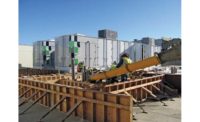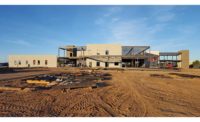Over the last four years, Hargrove & Associates Inc. has expanded throughout the region. The Alabama-based contractor has opened four full-service offices in Louisiana and Texas alone. New locations include Lake Charles, La., in 2018; Angleton, Texas, in 2017; Port Arthur, Texas, in early 2016; and Houston in 2014.
Since its founding in 1995 in Mobile, Hargrove’s strategy has been client driven; each of the new office launches was determined by existing clients—most of them in the industrial process, petroleum and power sectors—who asked Hargrove to bring its services to their area.
“We evaluate the areas in which our clients are growing and expanding and always take steps to grow alongside them, matching their stride and providing adaptable, boots-on-the-ground support,” says Ralph A. Hargrove, president and CEO. “These strong client relationships are the foundation of our success and have been the driving force behind decisions to expand.”
The firm’s $53-million increase in 2017 regional revenue over 2016 exceeded Hargrove’s own business expectations by more than 18%, says Shannon Cloud, a division leader and project director based in Hargrove’s Beaumont, Texas, and Lake Charles offices.
The company reported revenue of $136.8 million across the five-state region of Arkansas, Louisiana, Mississippi, Oklahoma and Texas, pushing it up to No. 11 in this year’s ENR Texas & Louisiana Top Design Firms ranking.
“All of Hargrove’s growth—1,800-plus teammates and growing—is organic,” Cloud says.
“Clients are going to the firms they have an established relationship with and who have historically provided a quality product at a fair market price,” says George Baquet, senior project manager in Hargrove’s Baton Rouge office.
Another factor in the firm’s strong 2017 performance was a mid-year upturn in the chemicals market, Cloud says. “Apprehensions about election outcomes and their global market impacts were big drivers behind the uptick in regional increases in capital spending,” he says.
As a result, Hargrove’s client base has been adding projects to previously scheduled turnarounds. “We have also seen efficiency measures our clients have implemented begin to pay off, along with the recent tax reform, allowing funds to begin additional projects,” Cloud adds. The first half of 2018 continued the growth trajectory at an even faster pace, he says.
Over the last 12 years, Hargrove and Performance Contractors Inc. have worked on a range of EPC projects together in prime and subconsultant roles, ranging from small-cap revamp projects to large-cap grassroots facilities.
“The Hargrove team is flexible and is always focused on the specific needs of the project and ultimately satisfying the client,” says Willie Lefever, vice president at Performance Contractors. “Hargrove has an excellent reputation in our industry. This is best indicated by their rapid growth, including their expanding client base, effective utilization of resources and their U.S. geographic presence near those client facilities.”
EPC Work
In the Louisiana and Texas region, Hargrove’s industrial process clients are becoming more and more interested in the firm’s engineering, procurement and construction (EPC) and engineering, procurement, construction and management (EPCM) capabilities. Hargrove’s full-service controls and automation system integration and commissioning and startup services also have been a strong differentiator for the firm.
The company provides site-based teams that work within client facilities, a practice that began with Ralph Hargrove, who led small capital-project engineering teams and worked exclusively on site until he founded his own firm.
While Hargrove has maintained many of its traditional deliverables and delivery methods, the firm is participating more often in the planning phases of projects. Clients also are embracing a front-loaded estimating approach, Cloud says.
“Clients are looking for an economical approach to completing their engineering projects,” notes John McGarigal, project director in Hargrove’s Houston office. “That being said, Hargrove is implementing more high-value engineering components to maintain a competitive edge in a tight market.”
Flexibility is key for Hargrove, since the delivery methods vary greatly from client to client and even project to project. “As our clients continue to change their operations to do more with less, we are discovering over and over again how important it is to listen to their needs and be flexible in how we provide help,” McGarigal says. “Many are choosing to execute projects in an EPC contracting strategy in order to reduce their direct risk and secure construction resources early.”
Hargrove currently manages the onsite project engineering and execution team for Shell Oil Products US, handling design, drafting and engineering needs for all small capital projects from front-end development through detailed design.
“I enjoy working with the Hargrove team. They pay attention to the details and they care about their people,” says Tammie Forbes, manager of capital projects at Shell. “They manage the uncertainty of our project workload and effectively respond to our request for resources.”
As the company expands and provides services for both larger companies and projects, Hargrove is increasing its expertise in advanced-work packaging to meet the growing demands of those projects.
“Not only has the number of projects increased but so has the size of projects. Our clients are not only trusting us with the $30-million projects, we’re now executing $300-million projects,” Baquet says. “Our base has always been small capital projects—under $100 million total installed costs—which we’ve maintained, while we’ve grown our capabilities for larger capital projects.”
Ted Springett, capital engineering manager at Syngenta Crop Protection, notes that the Hargrove presence on projects ranges from a single person designing a support beam to full-process design. Hargrove supplies onsite capital design requirements for the firm.
Recent projects for Syngenta included installation of a brownfield reactor system, including all disciplines, and the retrofit of another reactor system in the same area. “Hargrove was able to deliver the design required in time to enable a successful installation of both projects,” Springett says.
Hargrove recently led a distributed control system (DCS) migration for a chemical company in Freeport, Texas, done as a lump-sum EPC project. “Our controls and automation team successfully migrated over 3,800 DCS points in an operating plant,” McGarigal says.
The firm is also currently providing front-end and detailed design services for a chemical client in Chocolate Bayou, Texas. Many of the projects are fast-track and lump-sum, some already complete and others still under construction.
“We also worked with a major chemical plant to improve their backup systems after an incident and flooding from [Hurricane] Harvey. We had a very fast response time and worked around the clock to ensure our client was safe and back online,” McGarigal says.
For another chemical client in the region, Hargrove leads the inside and outside engineering for all 2019 turnaround projects, from front-end engineering design to detailed design.
“One of Hargrove’s biggest differentiators is our ability to provide controls and automation-system integration and panel fabrication alongside our engineering and construction support,” Baquet says.
SI Group Inc. began working with Hargrove’s Texas operations about three years ago on projects such as control-system migration, process-safety management, utility systems and maintenance capital projects.
“I think Hargrove’s success is largely based on their recognition that their clients do have specific needs and that projects should be executed in a way that balance functional, technical and commercial requirements,” says Cliff Nguyen, manager of engineering, Texas operations at SI Group. “Working with Hargrove, I do not feel like the projects are transactional. They listen to their customers. They provide services [rather than] dictating their services to the customers.”
Since 2002, Hargrove has steadily expanded and maintained a 98% retention rate among employees—even during the 2008-09 recession. The firm also has been recognized by Inc 500/5000 for the past 10 years as one of the fastest-growing engineering firms.
Employees, or teammates as Hargrove calls them, are the firm’s most valuable asset. Even as the market tightened over the years and most firms looked to cut their workforce, Hargrove did not. “Hargrove invests in their people by putting their time in, providing training, listening to their needs, giving chances for leadership and making the person feel valuable,” Baquet says. “At Hargrove, you’re at home, with family.”








Post a comment to this article
Report Abusive Comment